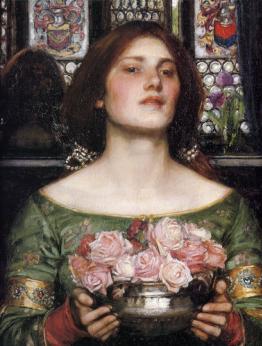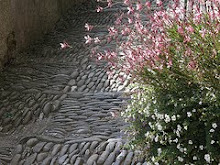
By Margaret Smith
GateHouse News Service
Jan 27, 2010
Montreal —
"Imagine walking along a remote ocean or sea shore, as turquoise waves call you to some exotic, distant place.
More beckoning still is the sight of a mermaid combing out her long hair, her eyes looking afar, a gaze at once mysterious and inviting.
A viewer can easily imagine encountering such a scene for real in the painting, “A Mermaid,” by John William Waterhouse, the British artist who embraced scenes of a mythical past even as his contemporaries emphasized edgier images of the everyday world.
An exhibit of his paintings is on view in “John William Waterhouse, Garden of Enchantment,” at the Montreal Museum of Fine Arts, in the only scheduled North American stop of a tour of the paintings.
 The exhibit – with paintings and artifacts on loan from The Tate Gallery in London, Leeds Art Gallery, and the Art Gallery of Ontario -- is the largest-ever retrospective of Waterhouse’s work, and the first international Waterhouse exhibit since 1978.
The exhibit – with paintings and artifacts on loan from The Tate Gallery in London, Leeds Art Gallery, and the Art Gallery of Ontario -- is the largest-ever retrospective of Waterhouse’s work, and the first international Waterhouse exhibit since 1978. Among the exhibit’s features are all three of Waterhouse’s paintings depicting “The Lady of Shalott,” the young noblewoman whose love of Sir Lancelot ended in tragedy.
Among the exhibit’s features are all three of Waterhouse’s paintings depicting “The Lady of Shalott,” the young noblewoman whose love of Sir Lancelot ended in tragedy.Visitors can learn more about Waterhouse’s life, times, and evolution of his style over his 50-year career, and gain greater understanding of his working methods.
At the same time, it’s a chance to be ensnared somewhere in a dream – perhaps in Cleopatra’s sun-caressed parlor, or in the florid garden of St. Cecilia, as angels greet the patron saint of music with a serenade of violins.
The paintings are arranged in a spacious and elegant walkthrough illuminated with soft lighting, and draped with dark curtains. Throughout are settings of flowers and ornate chairs, quietly echoing the assuring yet haunting worlds Waterhouse brought to life on canvas.
 The exhibit puts Waterhouse into the context of the art world of his day, including the emerging schools such as Impressionism in which Waterhouse found formidable competitors.
The exhibit puts Waterhouse into the context of the art world of his day, including the emerging schools such as Impressionism in which Waterhouse found formidable competitors.“Waterhouse knew a great deal about what was going on in the (more technically progressive) art worlds of Paris and Brussels -- partly through British friends who had returned from studying and working there, partly through artworks sent from those cities for exhibition in London, and partly through illustrated magazines and other publications available in London,” said Waterhouse biographer Peter Trippi, exhibit curator, editor of “Fine Art Connoisseur,” and author of an article in the exhibit’s catalogue.
Trippi said, Waterhouse and his contemporaries were excited by new techniques and ideas espoused by the Impressionists.
Some observers also see hints of Impressionist influence in Waterhouse works such as one his three versions of “The Lady of Shalott,” in which water lilies dot the lake where the doomed young noblewoman has taken her boat.
Ultimately, however, Waterhouse retained his own identity, and this, many argue, is what has allowed his work to endure.

The magic touch
If viewers find themselves bewitched, it’s more than coincidental. Inspired by many sources – classical mythology, Biblical and early Christian stories, the poetry of Keats and Tennyson, Shakespearean plays, and British folklore – Waterhouse created numerous images of women, especially those with magical powers.
 In “Medea and Jason,” the young witch Medea appears to create a potion while Jason watches. We know from the play by Euripedes that Jason betrays Medea, and that she wreaks a terrible revenge. But for the moment, he seems content to watch and perhaps even learn.
In “Medea and Jason,” the young witch Medea appears to create a potion while Jason watches. We know from the play by Euripedes that Jason betrays Medea, and that she wreaks a terrible revenge. But for the moment, he seems content to watch and perhaps even learn.A starker image of magic is seen in “The Magic Circle,” where a witch casts a circle around herself and a cauldron emitting clouds of ether, as magical portents – including crows and a toad – watch from outside the circle’s perimeter.
“The Symbolist painters (of which Waterhouse was one) were deeply interested in the occult, and so it’s not surprising that Waterhouse was, too,” Trippi said.
Spiritualism and other forms of mysticism were popular among the upper classes, in part because of changing attitudes toward religion – including Darwin’s challenge to the literal view of the Bible’s creation stories.
While it’s unknown whether Waterhouse was a member of any of the occult and mystical societies that were prevalent, Trippi said, “Certainly in his works--right from 1884 through his death in 1917--we see continuous expressions of interest in the occult, magic, the supernatural, transformations from one shape to another (e.g., human to plant, animal to human).”
 Feminine focus
Feminine focusAs enchantresses, queens, victims of injustice, saints, martyrs, mythical creatures, or femmes fatales, Waterhouse painted women predominantly as his main subjects.
In his mature works, they are unfailingly vivid in their expressions of love, fear, longing, sorrow, or contemplation of the world and their role within it.
Sensuality and even seduction can prevail, in ways that are wholesome and innocent, but also signaling possible danger.
A docent guiding a tour group pointed out an exquisite portrait of Circe, another great sorceress of classical Greek tradition, and a prominent character in Homer’s “Odyssey.” She wields her powers without apology, and thinks nothing of turning Odysseus’ sailors into swine that cower at her feet.
She’s also known for her ability to lure men with her voluptuous beauty. The docent remarked that this is seen in the diaphanous and revealing gown she wears. But, one tour member suggests that another clue to Circe’s passions is in her eyes.
 “Waterhouse's women have knowledge--the ability to both help and hinder men, who always appear as secondary figures in the compositions,” Trippi said.
“Waterhouse's women have knowledge--the ability to both help and hinder men, who always appear as secondary figures in the compositions,” Trippi said.One possible interpretation – far from being passive objects to be dandled by fate, the figures in the paintings are women of action. They are always possessed of their own ideas and feelings, and fully expressing them.
“Although we cannot be sure that Waterhouse was a feminist or supported the drive to secure women's right to vote, we can be sure that he admired women not just for their beauty and fertility, but also for their unique sets of knowledge and their closeness to nature," Trippi said.
He added, “Remember that most spiritualistic mediums (see above) were women, not men.”
Trippi observed that viewers in Waterhouse’s times were generally familiar with the stories he depicted, and likely looked at the paintings with their own understandings of the stories and characters.
Waterhouse has long had a popular following, and one doesn’t have to be an art authority to enjoy his work. But in recent years, there is a growing understanding and respect for Waterhouse’s technique among artists and art historians.
 Trippi said, “We are seeing a groundswell of admiration of Waterhouse's technical excellence (brushstrokes, coloring, glazing) thanks to this traveling exhibition. Photos of his art are lovely and colorful, but nothing prepares you for the rich, almost voluptuous, experience of seeing these masterworks properly lit and framed.”
Trippi said, “We are seeing a groundswell of admiration of Waterhouse's technical excellence (brushstrokes, coloring, glazing) thanks to this traveling exhibition. Photos of his art are lovely and colorful, but nothing prepares you for the rich, almost voluptuous, experience of seeing these masterworks properly lit and framed.”And little compares to the fantastical yet unexpectedly personal and familiar realms into which Waterhouse invites his viewers, places that are spellbinding, unsettling, and compelling as any siren’s song." - Margaret Smith, GateHouse News Service

1. A Mermaid, 1900
2. The Lady of Shalott, 1888
3. The Lady of Shalott, 1894
4. Cleopatra, 1888
5. St Cecilia, 1895
6. Jason and Medea, 1907
7. Circe Offering the Cup to Ulysses, 1891
8. Circe Invidiosa: Circe Poisoning the Sea, 1892
9. Lamia, 1909
10. Nymphs Finding the Head of Orpheus, 1900
The exhibit, John William Waterhouse, Garden of Enchantment, will be at the Montreal Museum of Fine Arts through 7 February, 2010.
http://www.mbam.qc.ca/waterhouse/en/


























No comments:
Post a Comment